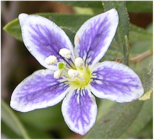This National Science Foundation funded project (with co-PI Dr. Rachel A. Levin) examined evolutionary relationships among three closely-related genera (Grabowskia, Lycium, Phrodus) in tribe Lycieae in the tomato family (Solanaceae). We have traveled widely with students to document distributions and collect species in this group.
Our work has resulted in revised taxonomic classifications and provided a new systematic treatment for the tribe. In addition, this research has explored variation in sexual systems (i.e., separate male and female plants versus hermaphroditism) and tested working hypotheses concerning the association of polyploidy, loss of self-incompatibility, and gender dimorphism. More broadly, this project has advanced our understanding of angiosperm phylogeny, as well as contributed to on-going, global efforts toward deciphering relationships in the economically important plant family Solanaceae.










